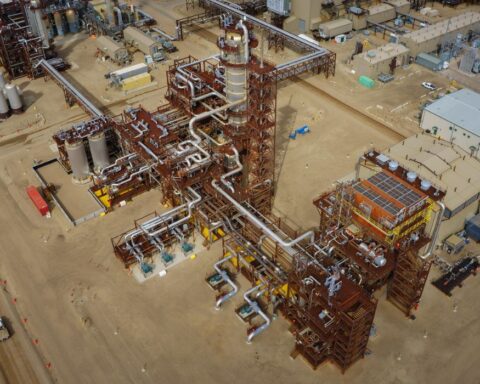Looking back on a year when record-breaking wildfires effectively negated Canada’s entire carbon-reduction effort for 2023, the news wasn’t all grim: the pace of public funding for renewables continues to grow, and the market for wind and solar has been especially robust. Global investment in renewables in 2023 outpaced fossil fuel investment by US$700 billion, the International Energy Agency (IEA) reports. As well, the watered-down declaration from the COP28 climate summit in Dubai marked, according to the conference president, “the beginning of the end” for fossil fuels and included a pledge to triple renewable-energy capacity and double energy-efficiency improvements by 2030.
Some important developments are coming for this year, including the ways in which we plan cities, emerging applications for artificial intelligence in the energy transition, and the comeback of traditional ideas about how we design buildings in a warming climate. Here are four trends to keep an eye on. ‘
AI and renewable energy
The broad acceleration of both private and public investment in renewables, charging stations for electric vehicles, and electric heat pumps is continuing to amplify the complexity associated with managing electricity grids on both the supply and demand sides of the energy market. According to industry experts, the massive uptick in both AI computing power and emerging applications for large language models holds out the promise of sharply improved demand forecasting and grid management systems.
“Consulting firm Indigo Advisory has counted more than 50 possible uses for AI in the energy sector,” Reuters reports. “The company estimates that 100 vendors have already introduced AI solutions into their products and that the market for AI is now worth up to US $13 billion in the energy sector alone.”
In a commentary published in December, the IEA noted that links are deepening between the power system and the transportation, industry, building and industrial sectors. “The result is a vastly greater need for information exchange – and more powerful tools to plan and operate power systems as they keep evolving.”
The inputs run the gamut from the growing inventory of solar and wind farms to the data that is gathered by sensor-based home heating systems and shared with utilities or equipment providers.
Other highly promising applications, according to the IEA, include the use of machine learning algorithms and the deployment of sensors on grid assets like power lines to predict the maintenance requirements and thus reduce downtime in order to optimize energy production.
‘Unplanning’ reaches critical mass
Urbanists have understood for many years that dense, compact cities represent the most effective way to build low-carbon urban regions. But zoning laws and seemingly bottomless highway budgets have long conspired to produce, in North America anyway, a tenacious sprawl cycle that has greatly exacerbated global warming.
Yet the housing affordability crisis that has inundated big cities in many countries seems to have finally forced local, regional and national governments to cast aside some of the most sacrosanct principles of planning in favour of blanket “up-zonings” and a broad relaxing of other rules governing development and parking.
This epochal shift in outlook, akin to changing the direction of an ocean liner, didn’t begin last year, but it feels like 2023 will be remembered as a critical turning point – the moment when the post-World War II planning consensus finally gave up the ghost.
Justin Trudeau’s Liberal government took the constitutionally risky step of using lucrative federal “housing accelerator” grants as a carrot/stick technique to force municipalities to increase minimum residential densities across the board, and the seeming success of this initiative has attracted the attention of a growing number of cities of various sizes.
In the U.S., Minneapolis, California and Oregon have led the way with zoning reforms that triggered a boom in so-called accessory dwelling units (small rear-yard dwellings) and multi-unit residential buildings with significantly less on-site parking. Last year, a bi-partisan “YIMBY” act was tabled in Congress and aims to provide a similar set of incentives as Canada’s Housing Accelerator grants. Also as in Canada, the momentum and expert consensus behind such reforms – which expand supply but don’t necessarily create a lot more affordable housing – means they’ll almost certainly spread to many other parts of the U.S. in the coming year.
The single-staircase ‘radicals’
For decades, multi-unit residential buildings have been required, and with good reason, to provide at least two sets of exits/entrances to satisfy fire safety regulations. But for generations prior to the advent of such rules, many apartment buildings, especially low-rise ones in the core areas of older cities, were constructed around a single central stairwell – a configuration that allowed apartments to have not only more exterior windows but also cross-breeze ventilation. (The staircases often encircle an elevator shaft.)
Why? The central staircase in those older buildings allowed units to, in effect, straddle a corner, which means that windows could be opened in such a way as to allow the air to flow through, thus providing inexpensive and low-carbon cooling and ventilation. In the apartments of the fire-code era, by contrast, apartments tend to be situated on either side of a central (aka “double loaded”) corridor, which means there’s no possibility of cross-ventilation.
Numerous climate-minded architects have been trying to crack the riddle of how to bring back single-staircase design without compromising safety. The other benefits, according to proponents: more efficient use of space, better light, better apartment floor plans, including layouts suitable for families with children.
A related trend is the design of mid-rise European-style apartment blocks built around a central courtyard and, crucially, single-loaded corridors that overlook this space. These corridors also permit cross-ventilation – they can be outdoor spaces or enclosed but with windows that open on one side into the apartments and on the other onto the courtyard space.
In North America, California is leading the push to reform its outdated building codes. Last October, the state legislature set in motion a process to develop changes to the building code meant to allow single-exit multi-family buildings.
Will 2024 be geothermal’s breakout year?
The prospect of tapping into the energy from the earth’s molten core has long been seen as one of the most promising forms of low-carbon heat. Volcanic regions, such as Iceland or central Turkey, have an abundance of relatively shallow reserves and do in fact rely extensively on geothermal energy. But in areas where the earth’s heat is much deeper, the cost of bringing geothermal energy to the surface has remained economically prohibitive.
In 2023, however, policy-makers in the U.S. and Canada stepped up investments in geothermal systems, through, for example, the Inflation Reduction Act’s 30% tax credit and a $200-million loan by the Canada Infrastructure Bank to Enbridge Sustain, which builds and operates residential clean energy systems. This could be geothermal’s breakout year.
Much of that funding is directed at stoking the geothermal heat-pump market for residential use, and in particular new subdivisions. In Barrie, Ontario, for example, Enbridge is partnering with a local builder, Sean, to construct a 73-unit development that will use geothermal, as well as other green building techniques, such as solar shading and cross-laminated timber.
Yet the development of large-scale, commercial geothermal power plants to provide baseload energy remains in its infancy in much of North America (except for hot spots in places like California), despite the enormous potential and falling costs due to technology improvements, which make it competitive with coal, nuclear and some solar applications.
The Swan Hills geothermal power project in Alberta came online in early 2023, and several others in Western Canada are in the pipeline. While the U.S. is the world leader, with more than 3,500 megawatts of geothermal capacity, countries like Indonesia, Turkey and the Philippines have seen substantial new investment in recent years, the IEA says.
At least one Canadian venture, Deep Corp., has raised $52 million in private and public capital to use spent oil and gas wells in Saskatchewan as conduits for accessing geothermal reserves. Its plant is expected to come online next year.







